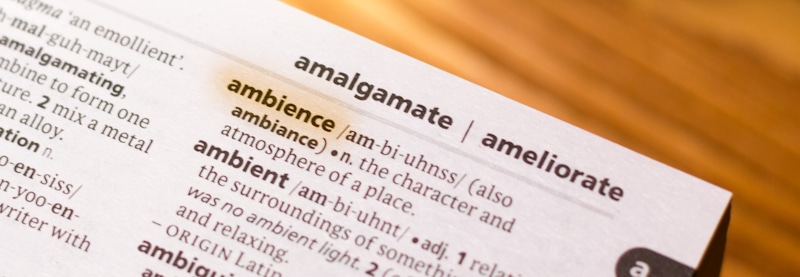Two words that continue to confuse most English speakers and writers are “ambiance” and “ambience.” Trying to pick the right word to use in a sentence or statement can be extremely confusing. So, it is okay if you are wondering, ambiance vs. ambience, which one should you use when writing.
“Ambience” refers to the mood, atmosphere, and character of a specific place or environment. This is also the same as the word “ambiance.” Precisely, they convey the same meaning and can be used interchangeably. Now, while there is no difference between both words, “ambience” is the more popular choice.
Now, we bet you are wondering what the fuss is about between both words. Well, in some cases, one option is preferred over the other. Are you wondering what this is all about? In this article, we will tell you all about their usage when writing.

When to and How to Properly Use “Ambiance”
Now, just as you must know, the word ambiance concerns a particular environment’s atmosphere and mood. In most cases, this results from a wide variety of factors such as the location, color and decoration, structural design, and individuals present. Even more, in some cases, things like the smell of cooking can contribute to the ambience of a room.
However, that is hardly our main concern. Our main concern is how to use the word “ambiance” properly in a sentence. Well, this word is a modern variant that conveys the same meaning as the older version.
It has become quite popular in recent times. Typically, you can use this variant in a sentence where you wish to convey a room or place’s mood. There is no limitation as long as that is the meaning you intend to convey.
However, keep in mind that most people use this variant more popularly in daily conversations and publications. Note that this use is not limited to one version of the English language. Rather, its usage span across American, Canadian, Australian, and even British English.
Again, remember that as long as what you intend to convey is the atmosphere in a room, you are free to use this variant. You will not be found guilty of its wrong usage. In the same vein, the meaning will remain the same, even irrespective of your choice of language.
Examples of its usage include:
- The slow songs, low lighting, scanty look, fireplace, and courteous attendants gave the restaurant the most pleasant ambiance ever.
- The popular inn at Molde, the Inn of Hawke, has this pub ambiance that is complemented by the best selection of beers you will ever see.
- Bernal Heights in San Francisco comes with the ambiance of my small village thanks to its public boards, small shops, little population, and the popular wild coyote that everyone is concerned about.
- It is quite possible that the calm and relaxed ambiance in your town is thanks to the absence of improved technological devices.
Regardless of the above, it would help if you remembered that this variant is preferred in some circumstances. Precisely, people prefer to use the word “ambiance” when referring to design and art. Still, this is not a hard and fast rule. It is merely based on preference.
As such, you can use the word “ambience” even when referring to arts or design, and you would not have a problem. In both cases, you will be grammatically right to use them both. Examples of correct usages include:
- The ambiance that comes with Picasso’s work is both inspiring and intimidating at the same time; I have hardly experienced a better feeling.
- The ambience that comes with Picasso’s work is both inspiring and intimidating at the same time; I have hardly experienced a better feeling.
- I could go on and on about the pleasant ambience that the sculpture brings to the room, and I would still be unable to express myself fully.
- I could go on and on about the pleasant ambiance that the sculpture brings to the room, and I would still be unable to express myself fully.
As you can see, both variants have been used in the same sentence and have conveyed the same meaning.
When to and How to Properly Use “Ambience”
We bet you can now tell that “ambience,” conveys the same meaning as “ambiance.” They are both used to describe the mood in a room, house, or place as influenced by various factors. These factors can range from color to structure, to music and sound, and even location.
Now, as to its correct usage, first, remember that “ambience” is the older version of the word. Precisely, the English language has seen the presence of ambience than it has seen that of ambiance. In turn, it fits into all circumstances where the meaning you intend to convey is the atmosphere of the room.
Still, keep in mind that this variant remains more preferred in some instances than the new version. Precisely, the word spelling of “ambience” is preferred when writing in British English. This is because the British prefer that a word retains a spelling that distinguishes the new word from its source or origin word.
In this case, the word “ambience” originates from the French language. Now, in French, the word has its spelling as “ambiance.” So, it becomes more elegant and formal to retain the spelling as “ambience” rather than “ambiance” as used normally by the English people.
Regardless, as we have identified above, both words – “ambiance” and “ambience” – are of interchangeable usage. So, using the word “ambiance” instead of “ambience” when writing in British English would pose no grammatical error. Even more, it will pose no problem as they will both convey the same meaning to everyone.
In the same way that these words have equal meaning they have equal uses, so you should not have any problem using both words interchangeably.
Other Examples Are
- I loved visiting Grandma’s house, the ambiance was always cozy and welcoming.
- His family’s country house ambiance inspired me to write a story of summer and love.
- Her friends always preferred hanging out at her place. Her bedroom had such a dreamy ambience, it invited everyone just to chill and be themselves.
- The ambiance in the party was not of celebration, more of good bye and nostalgia.
- I don’t care for money or glam, I just want my place to have an ambiance that is inviting and home like.
- They were so energetic, their presence altered the ambience of the room.
- The difference between a home and a house for me is always the ambiance, one feels like a rental, the other like you built it with your own hands.
Is There Any Difference in Both Words?
Just to be clear, there is a difference between both words. However, the difference exists only in the spelling. While one of the words has an “A,” the other one comes with an “E.”
Now, you might be wondering why despite the difference in spelling is the same word. Well, this difference occurs thanks to their respective connection with the original or source word, one derived from the French and the other one from older forms of British English.
Like we stated above, the word “ambiance” is primarily French. In fact, it is the source of the English word “ambience.” However, when the English word got derived from the French word, the British adopted an anglicized version. This version is what adopted the use of “E” and gave rise to “ambience.”
At this time, the word ambiance was not an English word; neither was it part of any English language. So, you could not find the word ambiance in either British English, American English, Australian English, or Canadian English. In fact, at that point, it would have been grammatically incorrect for anyone to use the word “ambiance” in an English sentence as it would have been a mixture of English and French.
However, later, the French version, ambiance, got adopted into the English language. It was from that time onward that both variants became applicable and correct under the English language.
However, apart from that, there is no identifiable difference between both words. They both convey the same meaning, you can use them interchangeably, and there will be no problem.
Final Thoughts

While the spelling might bring some confusion, there is no reason to remain confused. The reality is that both words convey the same meaning without any distinction whatsoever. No doubt, while one word is older and more popular in English usage than the other, they are the same.
As such, you can use them interchangeably in any sentence. You can also count on the fact that their meanings will not change in any way whatsoever. And, of course, you will not be making any grammatical errors due to such usage.
So, now that we have cleared up, you can go on and use both words with some peace. It would still be a good practice that when you write for British English speakers the spelling used was the one with “E” and for everyone else, non-British, use the French derived version with “A”.
Shawn Manaher is the founder and CEO of The Content Authority. He’s one part content manager, one part writing ninja organizer, and two parts leader of top content creators. You don’t even want to know what he calls pancakes.


